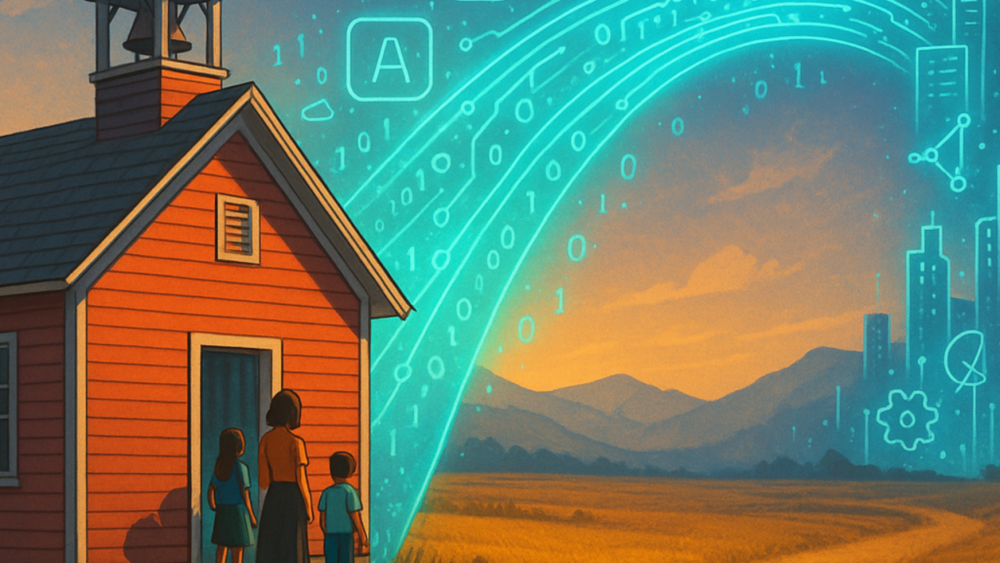Empowering Small & Rural School Districts in the Age of AI: A Model for Thoughtful Implementation
By Yuri Calderon
By Yuri Calderon, Executive Director, Small School Districts' Association (SSDA)
As artificial intelligence (AI) rapidly reshapes our world, California’s small and rural school districts face a unique challenge—and an opportunity. The education community is grappling with how to respond thoughtfully to an innovation that is simultaneously thrilling, disorienting, and disruptive.
In this shifting landscape, the Small School Districts' Association (SSDA) has taken a proactive step forward. Recognizing both the potential of AI and the risks it carries when left unchecked, SSDA has developed a model Artificial Intelligence Acceptable Use Policy and Administrative Regulations specifically designed for California's small and rural school systems.
This article introduces that policy—not just as a document, but as a critical resource to help districts chart their own course through the ethical, legal, and educational questions AI raises. We created this model because small districts often lack the bandwidth to independently draft such comprehensive guidance, even as they are equally vulnerable to the challenges AI presents. SSDA believes that by leading on this issue, we can help districts adopt AI tools in a way that is responsible, transparent, and centered on student well-being.
A Front-Row Seat to a Technological Revolution—Without a Playbook
Over the past few years, educators have watched from the front row as AI exploded into public consciousness. First it was speech recognition, then automated grading, then predictive analytics. And now—generative AI. Tools like ChatGPT, Gemini, and Claude can generate essays, answer prompts, write code, summarize texts, and imitate creative writing with startling fluency. Many of these tools are freely available, highly persuasive, and constantly improving.
For those working in classrooms, this rise has felt less like an innovation cycle and more like a tidal wave. It’s not just that AI changes how students do their work—it alters what “work” even means. Teachers have found themselves in an exhausting game of cat and mouse, trying to detect when students have used AI to generate essays or solve problems. But detection tools are increasingly ineffective, often producing false positives or missing obvious violations. Meanwhile, some AI tools are now trained to mimic human writing styles or even evade detection outright.
Educators are rightfully anxious. Will AI replace writing instruction? Will students lose the ability to think critically, synthesize information, or wrestle with difficult texts? Does this technology incentivize shortcuts over learning?
These are not abstract questions—they are deeply human ones. And while the answers are still evolving, one thing is clear: ignoring AI will not stop its impact. The only responsible option is to engage with it head-on, thoughtfully and with shared purpose.
Why SSDA Stepped In
SSDA developed this model policy because small school districts should not be left to figure out this future alone. Our members serve more than 650 communities across California—many with limited IT staff, no general counsel, and fewer centralized systems than large districts can rely on.
The policy provides a clear, adaptable framework to help districts:
Understand and define AI tools
in the context of instruction and administration
Protect student data
and comply with federal and state privacy laws
Maintain academic integrity
while teaching students to use AI ethically
Empower educators
to integrate AI responsibly into lesson planning, tutoring, and differentiated instruction
Ensure transparency
for families about what tools are being used and why
This is not just a compliance issue. It’s a leadership issue. And in the absence of strong guidance, vendors and unregulated tech platforms will fill the void.
The Tension: Fear vs. Potential
There is no denying the tension in the room. For every article about AI's promise, there is another about its misuse. School administrators worry about surveillance creep, inequitable access, and opaque decision-making algorithms. Teachers worry that AI will devalue human connection and creativity. Parents are uncertain about whether their children’s data is safe—or being monetized.
And yet, the potential for good is immense—especially for small and rural districts. AI tools can help with adaptive instruction, foreign language support, early warning systems for at-risk students, and streamlined administrative tasks. Properly used, these tools don’t replace people—they extend their reach and amplify their impact.
The SSDA model policy embraces this dual reality: AI is neither savior nor villain. It is a tool. And like all powerful tools, it must be governed with clarity, oversight, and purpose.
Ethical Guardrails Are Non-Negotiable
At the heart of the SSDA model policy is a commitment to ethics and student protection. It affirms that:
AI cannot replace the role of teachers or human decision-making.
AI systems must be transparent, explainable, and monitored for bias.
Students, families, and staff must be notified when AI is in use.
No critical academic or behavioral decision can be made by AI alone.
Student privacy and data security must be paramount.
Moreover, the policy explicitly prohibits uses of AI that promote academic dishonesty, violate privacy, enable surveillance, or perpetuate misinformation or discrimination.
It is not enough to say “we trust our staff.” We must provide them with tools and policies that help them navigate complex, fast-moving decisions with confidence and care.
A Model for the Future
The SSDA model policy is not meant to be adopted blindly. It is a living framework—designed to be adapted, refined, and built upon. Each district must tailor it to their unique context and community values. But the goal is simple: to help districts move from reaction to intention.
Artificial intelligence will reshape education in the coming decade. But how it does so is still up to us.
Let’s ensure that small and rural schools don’t just survive that change—but lead it.

